|
Dear friends,
Thanks for your love and prayers. Thanks too for all of your support and your encouragement. It means a lot to us here and lifts us up. We cannot do this work alone and are grateful to be on the same team.
Burma Army Car Roads
Here in Northern Karen State, the Burma Army continues to shoot and kill people, to rape and to destroy, to dominate and to hold on to other people’s land. In the past two months its main focus has been to move supplies and troops to its camps. The Burma Army has not launched any major offensives here in the north since its attacks in Mone Township, Nyaunglebin District between September and November 2008. However, because of where the new roads have been placed and the troops and camps on these roads, many villagers who fled during the height of the offensive (which displaced 30,000 people) in 2006 and 2007 still cannot go home. The roads not only enable the Burma Army to stock their camps and project their power more rapidly through the area, they also serve as formidable barriers to people trying to cross them. The roads cut through farms and villages, displacing all people along their axis, and separating communities from each other. The roads are patrolled and mined by the Burma Army, and thus act as barriers to travel, trade and the sending of relief. During this mission we have had to cross two of these roads to bring humanitarian assistance to people in need. With the help of the Karen Resistance (Karen National Union pro-democracy ethnic resistance group) we were able to cross the first road without incident. However, three days before we planned to cross the second road a Burma Army patrol shot and killed one Karen soldier and wounded another as they were trying to help villagers cross the same road. Again, with the help of the local resistance, we and IDPs who also needed to go were able to cross the second road, and to avoid the Burma Army.
The Enemy on the Road
Before we actually crossed this second road, we went to do a reconnaissance of a Burma Army camp and a road they had built in 2007. We sent most of our relief team to a nearby IDP site to give medical treatment and do a Good Life Club (GLC) program for women and children and then took a small team to photograph the Burma Army camps and road. This is a road that connects the town of Toungoo in the plains to the northwest to the Kyauk Kyi — Hsaw Hta road (please see map) that runs west to east and cuts through the middle of northern Karen State. The valley we went to is called Ler Mu Plaw and was once a major rice producing area for this region.
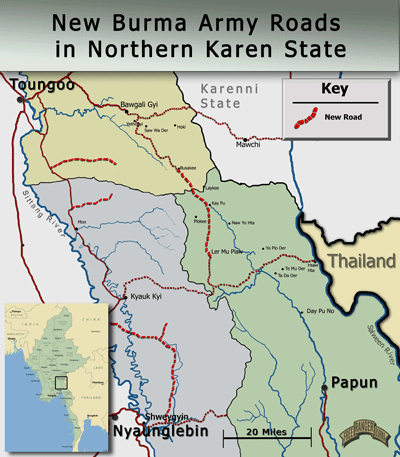 |
| Map of area showing new Burma Army car roads (FBR) |
From the side of a ridge we looked out over the now empty valley with charred remains of houses dotted across abandoned rice fields. One end of the valley was guarded by a Burma Army camp on a hill, and a road ran from the camp both ways. The southern extension ran south to connect to another road and camp network, and on to the Kyauk Kyi-Hsaw Hta road. To the north the road runs through the mountains and to the plains and the city of Toungoo. As we watched, a Burma Army column of about 100 troops marched north from a camp that dominates the Ler Mu Pla valley. At the northern end of the valley, and also on the road, was another column waiting to meet them. The Burma Army troops moved in a long column and trooped up the road though the valley cleared of all Karen villages. It was an empty valley, save for them.
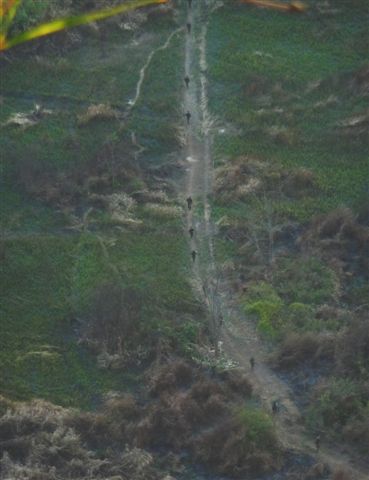 |
| Burma Army column moves on new road through Ler Mu Plaw valley (FBR) |
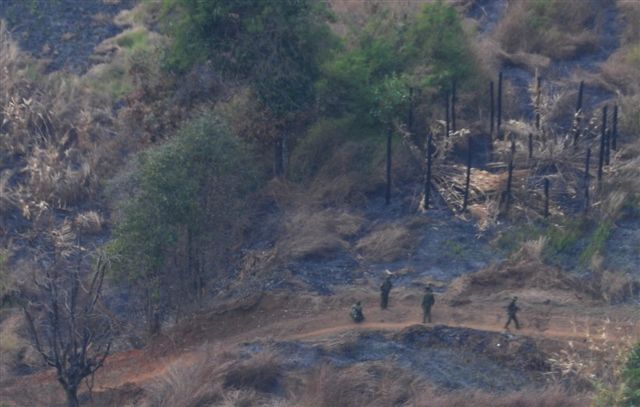 |
| Burma Army on road near burned house in Ler Mu Plaw (Partners) |
This was the same road that we would have to cross later and, unbeknownst to us, at this time families were trying to cross this very road eight miles to the north. Two Karen soldiers went ahead to check the road and to provide security for the families and were attacked by Burma Army troops who were hiding on the edge of the road. When we got back to the Karen IDP site where we had started that morning we heard that the Burma Army had killed one Karen soldier and wounded another. Both soldiers were shot in the road while checking to see if it was safe for the villagers to cross. When the shooting started the villagers trying to cross the road ran back and escaped.After the recon, and on the way to link up with the GLC/medical treatment team, we met the wounded soldier who had been trying to help people across the road when his fellow soldier was killed and he was shot. He was being treated by one of our medics and the local staff of the mobile clinic in this area. He said the Burma Army was waiting on the road, but he did not see them. He and his friend were standing on the road, radioing ahead. They were getting ready to bring the IDPs across when the Burma Army opened fire, shooting his friend to the ground and shooting at him. He tried to return fire but his ageing weapon jammed after the first shot. He ran to help his friend, grabbed him by the shoulder and tried to drag him off the road. His friend was hit again and killed and at the same time he himself was hit twice causing him to drop his radio. He let go of his now dead friend and ran off the road. He was helped by other Karen soldiers who were protecting the IDP sites and villages nearby. He was carried to where our team was doing the program for IDPs. One of our medics treated him and he was carried to a clinic.
On the way back to the clinic, we met a family with all their belongings. We knew each other as I had stayed in the village and they had seen us and our teams many times throughout the years. They said that because of the attacks of the Burma Army they could not stay in their homes any more. They were now fleeing further south where they hoped would be a safer place and where they could continue farming. We gave them some help for their journey and prayed with them. And, even though we were all unhappy that they were leaving their homes, it was good to see each other on the way.
We then continued on to the clinic where the soldier was being treated. He was in stable condition and while the medics cared for him we prayed for him and his wife, who was also there.
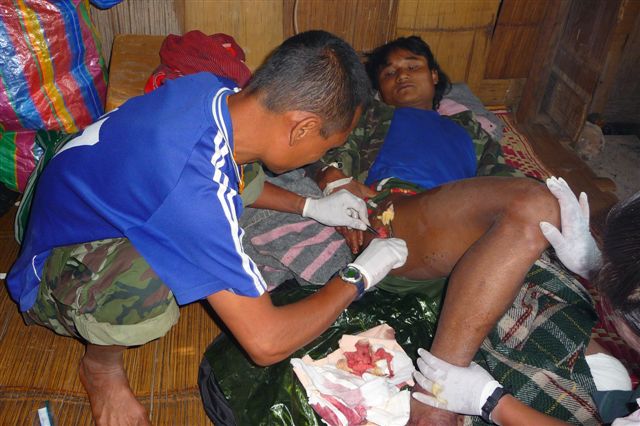 |
| Soldier who was shot being treated by medic (FBR) |
He was in pain but only asked us for a new radio and new uniform as his pants were ruined by the gunshots. The medics said they would leave both bullets in his leg as they had missed any vital organs and that he would make a full recovery. (As of this report he is steadily improving).We then went on and re-united with the GLC/medical treatment team. This team was just finishing up the treatment of patients and had handed out relief supplies.
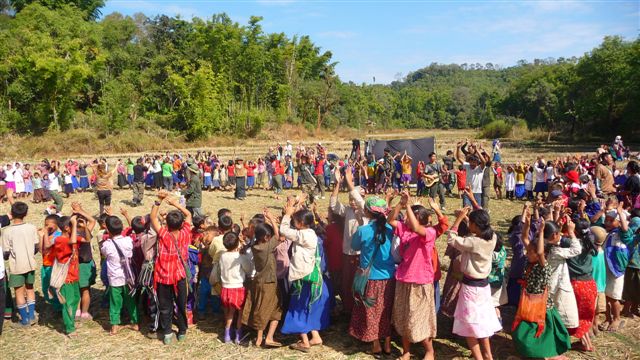 |
| Children play at GLC program (FBR) |
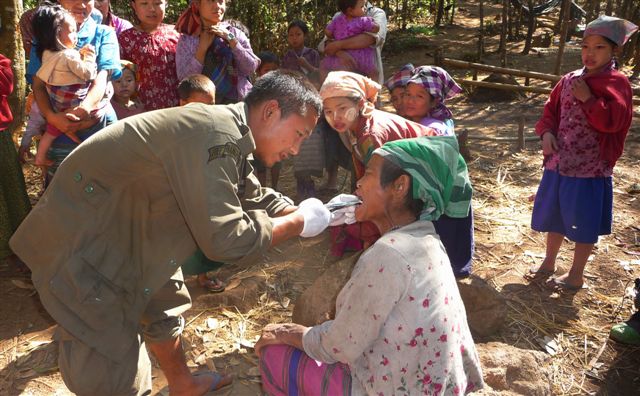 |
| Karen, Karenni, Shan, PaO, Kachin, Arakan and Chin medics give medical and dental treatment for IDPs (FBR) |
Mary Wah: The Human Cost
We played a soccer game with the people from the village and then, after that, one of the families came asking for a medic. They said that there was a lady named Mary Wah who was very sick, and that she apparently had overdosed on the anti-malarial drug quinine. It looked like she had tried to kill herself and was now in very bad condition. We were told her husband had stepped on a landmine two months earlier and died, and that she was in despair. (This was on the same road we had just looked at and the same one on which the Karen soldier had been wounded and his friend killed). We were told that two months ago in November 2008, the husband was crossing the road and stepped on a landmine which blew his leg off. In his agony he killed himself with his hunting rifle. His wife, Mary Wah, had now tried to kill herself. Even though she had a seven month-old son, she did not want to live. One of our team members from Partners who was part of the team that went to help her wrote the whole story down and this is his report:
| Mary Wa and baby the day after recovering (Partners) |
“Mary Wah is from Htee Po Lo, the oldest of 9 children. On November 11, 2006, at 11:10 am, Burma Army troops came to their village. They burned down 12-18 homes, shot and wounded one villager, and destroyed all their rice barns. Mary Wah, her family, and all the other villagers escaped unharmed but lost all of their possessions and homes. Mary Wah and her friends finished the school year in the jungle.
Her husband is from De Mee Hkee. They got married when she was 15 on May 24, 2007. Because of Burma Army activities they moved to their current hide site to try and survive. 7 months ago Mary Wah gave birth to a healthy baby boy.
Two months ago, Her husband Mo Chi Wah went to a nearby village for supplies. While on his way back home he stepped on a Burma Army landmine and died. The following day his body was found by other villagers.
On 13 January 2009, Mary Wah ate 50 quinine pills, 20 aspirin, and 30 antibiotic capsules. She was found on the floor of her bamboo hut by her neighbor. When our team arrived [where?] Eliya, Doh Say, and Tha U Wa A Pa were asked to come and help her. Our head medic, Eliya, arrived at her house around 10pm. She was in shock with low blood pressure. He administered medicine and got her on an IV. Tha U Wa A Pa and Doh Say prayed that God would heal her and minister to her. Her life was saved.
Doh Say and I went to pray for her the next morning. Later that day Tha U Wa A Pa and Tha Ka Paw Doh also went to pray with her and encourage her that God loved her, that many people, like her family and our team loved her, that God had special things for her to do, and that she was needed.
The night before we left, Doh Say and I went to pray with her again. I had a lot of things to do that day and was tired. I didn’t feel like going back across the river to meet her. Then Doh Say turned to me and said “You gave your word.” I felt convicted that I must do my duty, ashamed that I almost didn’t, and grateful that we did.
We brought her sweet cakes and milk. I talked to her mother who was there to help her and then bring her home when she recovered. Her mother said: “after her husband died she became helpless. She could not care for or feed her son.” Mary said “I felt very confused. I could not cope. I decided to kill myself.” Now as we talked and prayed she smiled and seemed encouraged.
I made her a bracelet with colors that symbolized God’s love . We gave her some help to take care of her son and I told her I would remember and pray for her. I prayed with her and Doh Say affirmed the value of her life as a child of God, a mother, and a woman with a future. As we left her parents told us, “Thank you so much and please come back when you can”.
K2
The next day we and our teams crossed this same road to continue the relief mission in northwestern Nyaunglebin District and southern Toungoo District, also known as K2. To reach the crossing point, we had to go through the Baw Kaw Pla Valley, that once held four Karen villages and high yield rice fields. On our last visit here, in 2006, we had visited these villages and the village schools and seen the local boarding school with over of 75 children from outlying areas in attendance. Even then, however, the Burma Army had established two camps that are on ridges overlooking the valley and had begun shelling the villages, especially targeting the school. After a year of constant shelling and casualties (including the boarding school headmaster), the villagers gave up and evacuated. Now the villages and schools are gone, along with almost all of the houses. The jungle is rapidly claiming the rice fields, gardens and orchards. A covered bridge at the entrance to what was the village still bears the sign “Gate of Hope”.
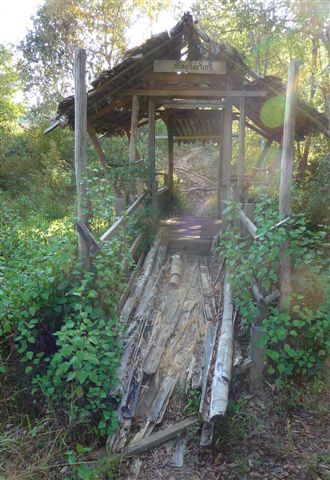 |
| ‘Gate of Hope’at abandoned school site (FBR) |
Because crossings of the car roads are so difficult, villagers must often wait for days, or even months, to successfully cross the roads. On the day we crossed, many villagers from both the north and south sides of the road crossed with us, carrying the children too young to walk, along with loads of belongings or things to sell in the neighboring regions. The KNU provides security, clearing for landmines before the crossing and securing both sides of the road as the people cross.
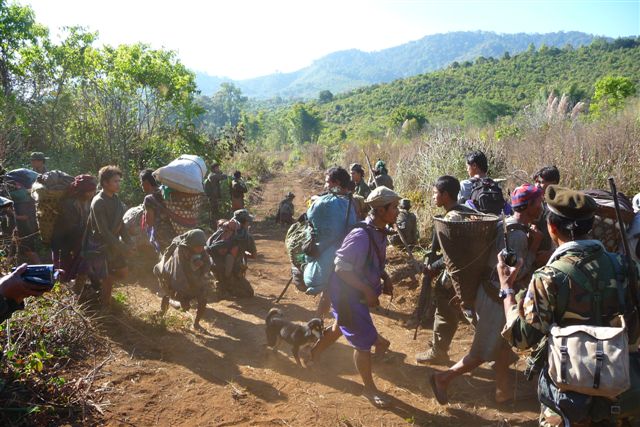 |
| Families run across the road during car road crossing (FBR) |
In the area we visited here there are over 9,000 people in hiding. We split the teams into three groups to try to cover most of this area. We went from village to village and hide site to hide site to provide medical and other care. The teams treated over 2,000 patients and gave out blankets, mosquito nets, clothes, and Good Life Club-mother and child packs.
Mr. Brave and the Flower of Di Htoo-born in hiding
The following is a story of two sisters and their aunt that exemplifies the people and situation here.
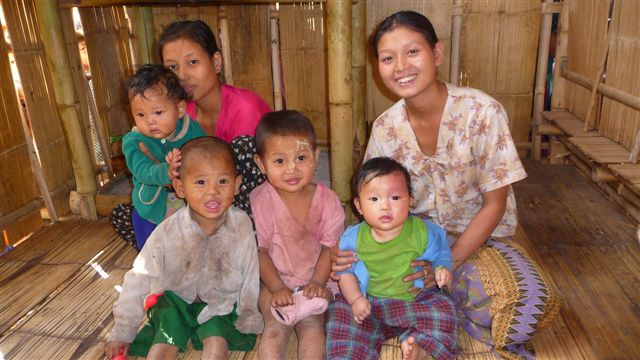 |
| Saw Brave, Naw Paw Di Htoo with mothers and family (FBR) |
The picture above shows two sisters and their children, all of whom we had met when they were in hiding in the 2006 offensive. Before we met them back in 2006, we had already met their niece, Naw Eh Ywa Paw, who had been shot in the stomach by the Burma Army in an attack in which the Burma Army killed her father and grandmother. After treating Naw Eh Yah Paw and giving a service for her father and grandmother, we had come to the hiding place where these two sisters were. One sister, Naw Rosemary, had just given birth to a baby boy. The other sister, Naw Moo Eh Paw, 24, was about to give birth and our medics Naw Di Htoo and Gideon (who later married) helped deliver a baby girl. Both sisters asked us to name the newborns, and so we prayed for the babies and named Rosemary’s boy ‘Saw Brave’, as he was born in a hiding place in the middle of an offensive to a brave mother. Naw Moo Eh Paw’s daughter we named, ‘Paw Di Htoo’ after our nurse who delivered her. The name means “Flower of Di Htoo”. Since the delivery they had had to flee many times and we had not seen them for almost two years. This time, when we came into the village where they were staying they both came to show us the children and to say “thank you”. We talked together and they joined in with the GLC program and were also given help to buy rice enough to take care of their families’ needs. Later on we talked to them and one of their aunts, Naw Ka Ree. Here are their stories.
Auntie Naw Ka Ree, 77 Years Old:
“In 2006 we were attacked the whole year. Sometimes we had no food. Thank you for your help when you met us in a hiding place then. I think you remember my husband K’Plae. He is blind. He is 75. Because he cannot see, he is now staying at a safer IDP place with other IDPs. But I came back to our old place here because these are my people and I want to be with them. So I go back and forth. “The same time as these attacks (2006) one of Naw Ka Ree’s friends, Naw Shwe Htoo, 65 years of age (aunt of Naw Eh Ywa Paw), spent two nights hiding without food in a cave after the group she was fleeing with was ambushed by the Burma Army and scattered. A week later she was able to meet up with another group, but they were also attacked and this time she went seven days without food. Another couple in their eighties, who have now fled to the Thai border, went five days without food as they hid near their destroyed village.
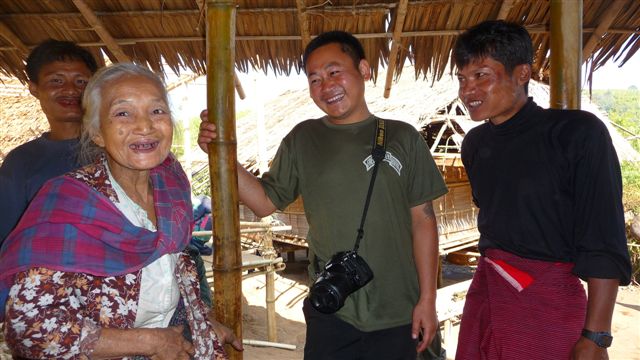 |
| Auntie Naw Ka Ree and relief team (FBR) |
Two Sisters: Naw Moo Eh and Naw Rosemary
Then the sisters, Naw Moo Eh and Naw Rosemary told us their story:”After you all left that first time we met in 2006, the Burma Army continued their attacks and we had to keep fleeing. The teams helped us and our organization helped us, but eventually we had to leave to another district. We always were yearning to come back home, and praying to be able to come back. We didn’t want to go to a refugee camp, and there was nowhere we could stay and work the fields. Everyone was suffering, and some could share their food with us and some could not. The Burma Army continued to attack and shell the villages and fields in our district, and we kept praying. Some friends were killed and some were wounded. We were tired, hungry, and afraid. Sometimes the Burma Army shelled every day. Our father is very old, and also did not want to, nor could he, walk to a refugee camp.
We continued to pray, and we cried out to God to help: ‘please let us stay in our home’. Finally after praying, we all felt we should try to go home. We heard the attacks had subsided, and even though there were new Burma Army camps in the area, we wanted to try. So we prayed and went in faith. We had no food, but we trusted God would provide something for us. We felt very sure He was helping us to come back. As we moved back to our old area, we realized we could not go back to our old village and farms, as they were now directly under a new Burma Army camp, so we climbed over a ridge and down into another valley, and to our amazement came to a field full of rice that had not yet been harvested. We found out that the owners of the field had fled before they could harvest, and would not be coming back, and that the farm was now abandoned. We began to harvest the rice and thanked God that we could now eat. Since then we have been back here, and we thank God and we thank you all. We have rebuilt our village. This is our home. Thank you so much for coming and for your help”.
TWO MORE CROSSINGS
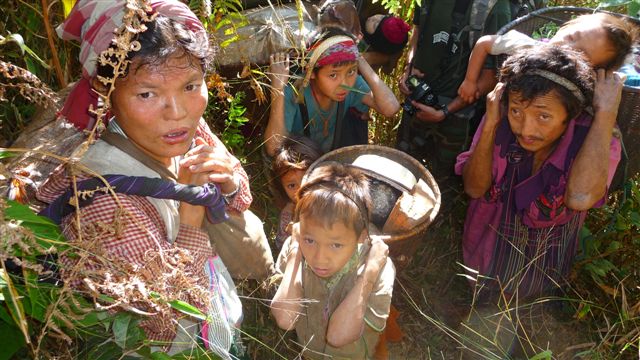 |
| Family rushing to cross the road waits for help (FBR) |
The teams continued to treat patients and go from place to place including a reconnaissance of a Burma Army camp and forced re-location site.(please see January 20 report: ‘The Shadow of the Oppressor’)We then all started the journey back to our starting point and needed to recross both roads we had crossed on our way into this area. Many IDPS joined us and on the other side of the road the Karen resistance led IDPs coming from the area we were headed. The resistance would secure the crossing and then our group would cross while those on the other side crossed over as well. We would all pass each other on the road.We moved carefully down to the road while the resistance watched the Burma Army camp that was on a hill above the road-crossing point. Karen soldiers positioned themselves on both sides of the road and aimed their weapons down each side of the road. The IDPs crossed at a run and some of us stayed on the road to help the IDPs cross.
When the last person had crossed, we left the road and thanked the resistance. We had moved about 200 yards down the trail from the road when two families of IDPs ran into us coming the other way. They looked terrified and were breathless. “Are we too late to cross, please we need to cross. We have run as fast as we could to catch up with the others.”
The mother was in front with a heavy basket on her back. Her children were next to her and her husband was behind carrying a heavily loaded basket with their youngest child curled up on top. The other family was behind them. Their eyes pleaded and the children were pushing to keep going. I turned to the security with us and said, “Let’s help them cross.” “It is too late,” he said. “The security on the other side has already gone back, but I will try to radio them.” He tried to contact the far side security for five minutes but could not reach them. He looked at me and I nodded and said, “Yes”. He said, “Let’s go.” We motioned for the families to follow and led them carefully to the road. We cleared both sides and guarded the road as they ran across. Once across they continued running to catch up to the earlier group. They made it.
We then rejoined our group who had waited further down the trail and continued through abandoned fields and villages to our next stop.We crossed a second road a few days later and are now completing the end of this January mission.
Thank you for your stand with the people of Burma,
God bless you,
A relief Team leader, Free Burma Rangers
Karen State, Burma
